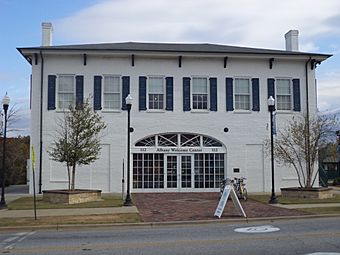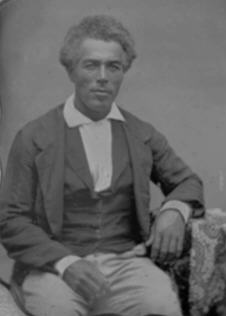Bridge House (Albany, Georgia) facts for kids
Quick facts for kids |
|
|
Bridge House
|
|

The Albany Welcome Center in the former Bridge House in Albany, Georgia
|
|
| Location | 112 N. Front St., Albany, Georgia |
|---|---|
| Area | 1 acre (0.40 ha) |
| Built | 1857 |
| Architectural style | Italianate |
| NRHP reference No. | 74000672 |
| Added to NRHP | November 19, 1974 |
The Albany Welcome Center is a special old building in Albany, Georgia. It used to be called the Bridge House. A talented African American architect and engineer named Horace King designed it in 1858. It's so important that it was added to the National Register of Historic Places in 1974. You can find it at 112 North Front Street.
Contents
Who Was Horace King?
Horace King was born into slavery but became a very successful engineer. He was known for building strong bridges across the American South. In 1858, the Alabama Legislature gave him special rights. This was unusual for someone born into slavery at that time.
Building the Bridge House
Colonel Nelson Tift hired Horace King in 1858. King's job was to build a covered bridge over the Flint River in Albany. His design for the bridge also included the Bridge House. This house was meant to be a grand entrance to the city.

The Bridge House During the Civil War
During the American Civil War, the Bridge House played a role in supporting soldiers. The building's lower levels were used to prepare food. Thousands of animals were processed there. Their meat was preserved in barrels to feed the Confederate army.
Tift's Hall: A Social Hub
On the second floor of the Bridge House was a large room called "Tift's Hall." This room was a very important social center for Albany. Colonel Tift hired artists from New York to decorate the walls and ceilings. They painted beautiful frescoes, which are paintings done on wet plaster.
What Happened in Tift's Hall?
Tift's Hall was a busy place. It hosted many different events and people. Actors would perform there, and people would gather for dances. Plays were also staged in the hall. For a time, it was also used for meetings by a certain social group.
The Bridge House Today
In 1887, Nelson Tift sold his bridge rights to Dougherty County. The county later built a new bridge nearby. For many years, the Bridge House was home to an auto parts store.
Restoration and Reopening
After a big flood in 1994, Dougherty County bought the building. This was part of a plan to improve downtown Albany. The Bridge House was carefully restored by a local architect named David Maschke. In August 2008, it reopened as the Albany Welcome Center. Now, it helps visitors learn about the city.



